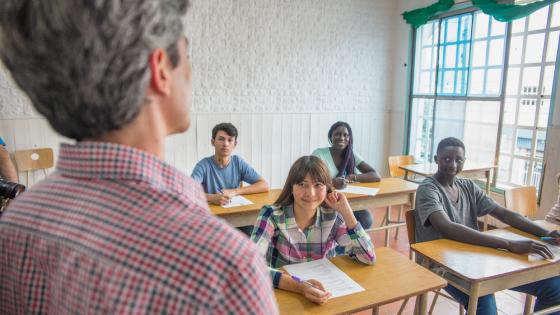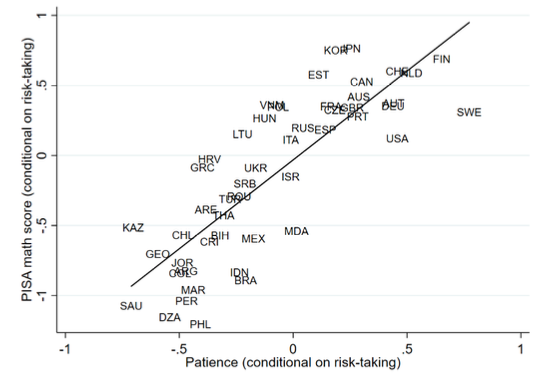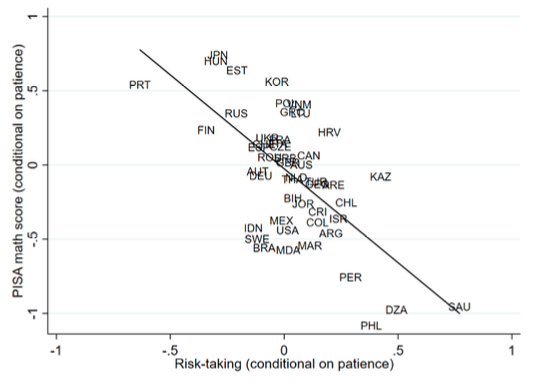Economists have long shied away from considering the role of culture in explaining economic phenomena – partly because that is the realm of other disciplines and partly because of concerns about measurability (Guiso et al. 2006). Various advances in empirical studies have, however, led to a growing understanding that elements of culture may have significant implications for economic outcomes (e.g. Alesina and Giuliano 2015).
In a new analysis of international differences in test scores, we explore how cultural differences are related to the variations in student achievement (Hanushek et al. 2020). These measured skill differences matter because they are strongly related to both future individual earnings (Hanushek et al. 2015) and national economic growth (Hanushek and Woessmann 2012, 2015).
The role of culture in educational investment decisions
At their heart, educational choices and human-capital-investment decisions are inextricably linked to intertemporal outcomes, weighing costs (invested time, effort, and resources) that accrue in the present against payoffs that accrue in the future. While investment decisions are generally viewed from an individual perspective, many decisions on educational inputs – in particular about public investments and school institutions – are collective decisions, putting the cultural aspect of group preferences, rather than individual preferences, at centre stage.
Therefore, cultural traits that underlie intertemporal decision-making such as time preferences (patience) and risk preferences (risk-taking) will be key to educational investment decisions.
Schooling investments require patience on the part of the investors because they take time to effectuate and even longer before any returns are realised.
Decisions to invest in human capital also involve considerable risk, and different channels ranging from chances of successfully completing schooling to variations in wages and employment in the future predict opposing effects of risk attitudes. Considering how risk enters into the schooling process itself, elements emphasised in the crime literature (e.g. Freeman 1999) come into play: a culture of risk aversion may discourage students from getting into trouble, spurring their efforts in studying.
The intertwined character of patience and risk-taking
Recent analysis suggests that there are distinct differences across countries in preferences related to patience and to risk-taking. The Global Preference Survey is a scientific effort to elicit common measures of preferences across countries (Falk et al. 2018). By validating survey questions with laboratory experiments, the developers of the Survey could provide rich data for 76 countries on their distinctly different preferences.
Patience and risk-taking are strongly positively correlated (at 0.358) across countries: countries with a high degree of patience are also willing to take greater risks. Behavioural economists have emphasised the inherent interrelatedness of patience and risk-taking (Halevy 2008, Andreoni and Sprenger 2012). Since only the present can be certain and the future always contains an element of uncertainty, it is inescapable that the two preference components are intertwined. One cannot consider the impact of patience without simultaneously considering risk-taking and vice versa.
We combine the Global Preference Survey data with data on educational achievement from the Programme for International Student Assessment (PISA). The data covers close to two million students across 49 countries, observed in seven waves during 2000–2018. These data allow us to estimate international education production functions at the student level, bringing out how country differences in cultural traits relate to the skills acquired by students.
Patience and risk-taking account for a large part of international achievement variation
In a cross-country descriptive analysis, we find a strong and competing relationship between the two intertemporal cultural traits and students’ educational achievement. As shown by Figure 1, patience has a strong positive association with PISA math test scores across countries.
Figure 1 Patience and student achievement across countries
Source: Hanushek et al. (2020).
By contrast, risk-taking has a strong negative association with test scores (Figure 2). The two cultural traits together account for two-thirds of the variance in average student achievement across countries (R2 = 0.672).
Figure 2 Risk-taking and student achievement across countries
Source: Hanushek et al. (2020).
While some studies have looked at one or the other cultural trait separately, the structure of preferences across countries has direct implications for each of the underlying elements. Our results show that looking at one element without considering the other leads to dramatic underestimations of the influence of both cultural traits.
The relationships hold across different subjects (math, science, and reading), across subsets of countries, and after considering differences in students’ test-taking efforts. Consistent with national cultures having a leading role, the relationships are stronger for the native students in each country than for migrant students (who have less exposure to the cultural factors of the residence country).
To investigate potential channels through which the cultural traits might operate, we construct four country-level variables (family inputs, school inputs, institutions, and residual productivity) and regress them on the two cultural traits. These results suggest that patience and risk-taking are closely related to differences in family inputs and residual productivity, and patience also to school inputs, suggesting that all these factors may act as channels.
An identification strategy based on migrant students
It is possible to provide more credible causal estimates by looking at migrant students in the different PISA countries. PISA contains survey information about the country of origin for over 80,000 migrant students, who originate from 58 countries and reside in 48 countries.
Following Figlio et al. (2019), we assign migrant students the culture of their country of origin and study the performance of migrant children from different cultures in the same country of residence. By including fixed effects for each country of residence, we can separate the effects of cultural factors from potentially correlated effects of the education systems, economies, or any other common feature in each of the residence countries.
We find remarkably similar positive influences of patience and negative influences of risk-taking on achievement among migrant students. Students from home-country cultures that are higher in patience by an aggregate one standard deviation perform better in math by about 90% of a standard deviation. Students from home-country cultures that are higher in risk-taking by one standard deviation perform worse by about 30% of a standard deviation.
Consistent with an intergenerational persistence of home-country culture, these results are larger for migrant students who speak the language of their home country at home rather than of their current country of residence.
Results are insensitive to a number of robustness checks, including alternative definitions of the migrant population and several adjustments for the selectivity of migration. Interestingly, none of the other cultural measures contained in the Global Preference Survey – trust, altruism, positive and negative reciprocity – enter the analysis significantly.
Culture matters for skill development
International differences in student achievement are at the forefront of education-policy debates, but the deeper reasons for why students in some countries perform better than in others are not well understood. Our analysis suggests that cultural factors – patience and risk-taking – are potential fundamental determinants of student learning. The new findings add a layer to the study of more proximate determinants of international student achievement such as families, resources, and school institutions (Hanushek and Woessmann 2011, Woessmann 2016).
In highlighting the central nature of preferences underlying intertemporal decision-making, our perspective combines the usually separated literature about optimal human-capital investment and about education production functions. On the one hand, perhaps the most successful empirical development in economics is the Mincer model of human capital and labour-market earnings (Mincer 1970), which focused on the time cost of skill development and made human capital virtually synonymous with years of school attainment. Its focus on individual choices spawned a variety of studies on optimal investment in human capital (e.g. Ben-Porath 1967, Heckman 1976, Rosen 1976) and laid the foundation for a generation of labour-market investigations.
On the other hand, direct investigation of the production of skills has developed almost entirely separately from the study of optimal human capital investment (Hanushek 1986). Analyses of educational production functions typically look at skill differences of individuals – measured by test scores – for individuals with the same years of schooling and concentrate on efficiency and aggregate policies. By treating these two lines of research jointly, our analysis of preferences and skills provides new insights into the deeper forces that affect human capital development.
References
Alesina, Alberto, and Paola Giuliano (2015), “Culture and institutions”, Journal of Economic Literature 53(4): 898–944.
Andreoni, James, and Charles Sprenger (2012), “Risk preferences are not time preferences”, American Economic Review 102(7): 3357–76.
Ben-Porath, Yoram (1967), “The production of human capital and the life cycle of earnings”, Journal of Political Economy 75(4): 352–65.
Falk, Armin, Anke Becker, Thomas Dohmen, Benjamin Enke, David Huffman and Uwe Sunde (2018), “Global evidence on economic preferences”, Quarterly Journal of Economics 133(4): 1645–92.
Figlio, David, Paola Giuliano, Umut Özek and Paola Sapienza (2019), “Long-term orientation and educational performance”, American Economic Journal: Economic Policy 11(4): 272–309.
Freeman, Richard B (1999), “The economics of crime”, in Orley Ashenfelter and David Card (eds.), Handbook of Labor Economics, Vol. 3C, Amsterdam: North-Holland: 3529–71.
Guiso, Luigi, Paola Sapienza and Luigi Zingales (2006), “Does culture affect economic outcomes?” Journal of Economic Perspectives 20(2): 23–48.
Halevy, Yoram (2008), “Strotz meets Allais: Diminishing impatience and the certainty effect”, American Economic Review 98(3): 1145–62.
Hanushek, Eric A (1986), “The economics of schooling: Production and efficiency in public schools”, Journal of Economic Literature 24(3): 1141–77.
Hanushek, Eric A, Lavinia Kinne, Philipp Lergetporer and Ludger Woessmann (2020), “Culture and student achievement: The intertwined roles of patience and risk-taking”, NBER Working Paper 27484.
Hanushek, Eric A, Guido Schwerdt, Simon Wiederhold and Ludger Woessmann (2015), “Returns to skills around the world: Evidence from PIAAC”, European Economic Review 73: 103–30.
Hanushek, Eric A, and Ludger Woessmann (2011), “The economics of international differences in educational achievement”, in Eric A Hanushek, Stephen Machin and Ludger Woessmann (eds.), Handbook of the Economics of Education, Vol. 3, Amsterdam: North Holland: 89–200.
Hanushek, Eric A, and Ludger Woessmann (2012), “Do better schools lead to more growth? Cognitive skills, economic outcomes, and causation”, Journal of Economic Growth 17(4): 267–321.
Hanushek, Eric A, and Ludger Woessmann (2015), The knowledge capital of nations: Education and the economics of growth, Cambridge MA: MIT Press.
Heckman, James J (1976), “a life-cycle model of earnings, learning, and consumption”, Journal of Political Economy 84(4): S11–S44.
Mincer, Jacob (1970), “The distribution of labor incomes: A survey with special reference to the human capital approach”, Journal of Economic Literature 8(1): 1–26.
OECD (2019), PISA 2018 Results (Volume I), Paris: OECD Publishing.
Rosen, Sherwin (1976), “A theory of life earnings”, Journal of Political Economy 84(4): S45–S67.
Woessmann, Ludger (2016), “The importance of school systems: Evidence from international differences in student achievement”, Journal of Economic Perspectives 30(3): 3–32.









